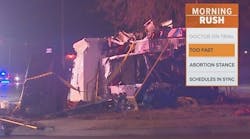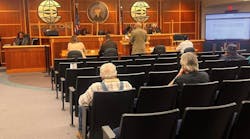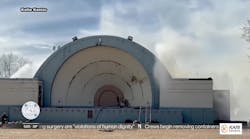Nov. 4, 1897: MARLBORO, MA An early-morning fire broke out in the three-story Central Hotel on Main Street. Flames raced through the wooden block, driving the hotel's 40 guests into the night. The fire spread to a commercial block of buildings nearby. Firefighters were able to contain the blaze before it could spread further.
Nov. 4, 1897: BOSTON A fierce fire raged through the Heywood Brothers & Wakefield Co. building, where rattan furniture was manufactured. The fire quickly spread from the Portland Street building to Lancaster Street, where another furniture company and a hardware store were destroyed.
Nov. 5, 1897: NEW YORK CITY The Red Star Line steamship Southwark, which had sailed a few days earlier toward Antwerp, Belgium, returned to New York Harbor with a fire in its forehold. The fireboat New Yorker met the ship and provided an escort to the pier at Fulton Street. The passengers remained on the ship as longshoremen opened the holds and firemen, who encountered heavy smoke between the decks, moved lines in to extinguish the smoldering bales of cotton below.
Nov. 6, 1897: GODERICH, ONTARIO The Grand Trunk Elevator, containing a large quantity of grain, was destroyed by a nighttime fire. The flames spread to a lumberyard and then across the city's waterfront. Two tugboats and a schooner were destroyed by flaming logs adrift in the harbor.
Nov. 6, 1897: TEXARKANA, AR One of the largest mills in the southwestern United States and surrounding properties was turned into a virtual "fire storm" during the morning. The blaze began in one of four steam-dry kilns and soon spread to five lumber sheds and more than 1.25 million feet of lumber. One of the burning structures, about 500 feet long, collapsed on about 40 mill employees who were working below. A whirlwind was created by the intense heat and struck a nearby building, reducing it to splinters. At least three men were killed.
Nov. 7, 1897: ST. AUGUSTINE, FL The Hotel San Marco, one of the city's finest structures, was burned to the ground by an incendiary fire. Firemen were hampered by vandalized fire equipment in the hotel. As firemen battled the blaze hundreds of men helped remove valuable furniture from the doomed building. All the guests escaped the fire.
Nov. 9, 1897: MILLEDGEVILLE, GA A section of the Georgia Insane Asylum caught fire and forced more than 700 patients to be evacuated. The fire started in the attic above one of the wards. The fire walls within the structure did not extend to the roof and fire was able to travel under the roofing dropping sparks below. Mutual aid was sent from Macon and the flames were brought under control after a 10-hour battle.
Nov. 20, 1897: PARIS A fire that broke out in a shop on the Rue des Pyrenees soon extended across two acres of buildings in northeast Paris. A large number of houses and workshops were destroyed by the advancing flames. Firemen battled the blaze for more than six hours. The exhausted firefighters, many of whom dropped were they stood, hoses in hand, were relieved by 250 soldiers who were brought in to overhaul the ruins.
TIME CAPSULE
Nov. 19, 1897: Another "Great Fire" Strikes In London
The "Cripple Gate" area of London was noted for its old, close-packed buildings and narrow streets. This area was the center of a fancy-goods district specializing in trimmings, paper decorations, candies, feathers and other highly flammable items.
Just after lunch, fire broke out in the cellar of a company that sold ostrich feathers. The factory was filled with girls at work who were driven to the roof of the six-story structure. As flames raged out the front of the structure and began igniting nearby buildings, the girls scrambled to safety across rooftops.
A delay in notifying the Fire Brigade would only intensify the monumental problems the firemen would face. Despite years of building inspections and the pleading of brigade officials, little had been done to make the area more fire safe. Most of the large buildings were not divided by fire walls and flames began to sweep throughout the buildings and leap from one structure to the next.
In the path of the fire was Saint Giles's Cripple Gate Church, famous for its association with English poet John Milton. The church, built in 1100 near the ancient city gate, contained the tombs of Milton and many other notables. The Fire Brigade made a valiant stand and saved church records, including the wedding records of Oliver Cromwell, and other historical treasures.
As fire spread throughout the district, firemen battled the blaze from every vantage possible. Firemen rescued other firemen cut off as buildings burned away beneath them, and walls collapsed around them. Fifty-one steam fire engines and 228 officers and firemen worked feverishly and finally quelled the flames. By the end of the day, more than 100 buildings lay in ruins.
The City of London was no stranger to the ravages of fire. The conflagration known as the "Great Fire of London" occurred Sept. 2 through 6 in 1666. More than 436 acres of the city burned, as 13,200 houses were lost on 400 streets.
Paul Hashagen
Compiled by Paul Hashagen




